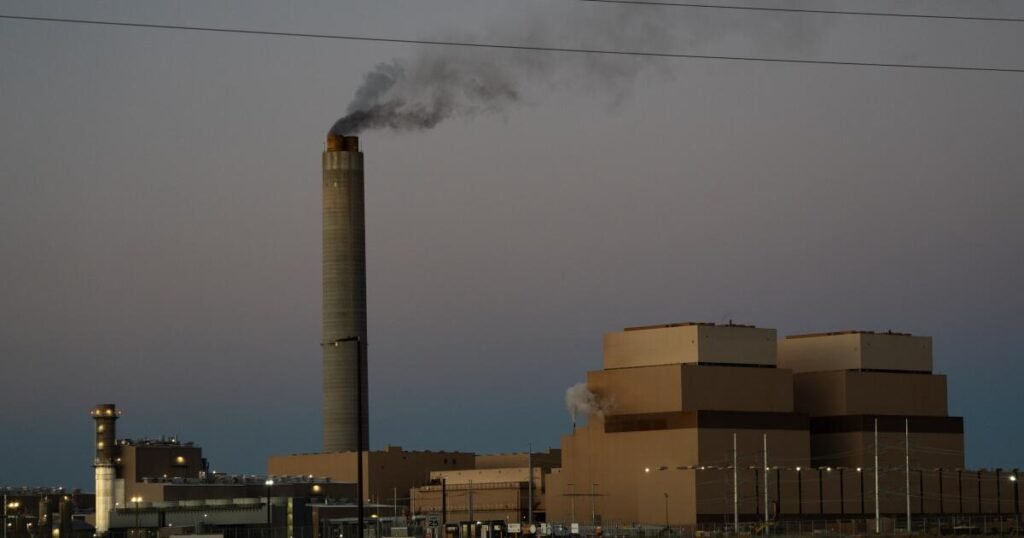Intermountain Power Plant’s Transition from Coal
Visiting the Intermountain Power Plant last month felt somewhat eerie. It was surprising to see the management building stripped of desks, with piles of boxes and office supplies left behind. Major changes were evident—the coal supply in the back area looked significantly smaller compared to my last visit in 2022.
“We aim to avoid leaving coal left behind,” mentioned Kevin Penn, the external generation manager for the Los Angeles Department of Water and Electricity, who guided me through this expansive coal-fired facility in central Utah. Despite being over 500 miles away from Los Angeles, where it has been a power source for four decades, it’s not completely out of operation yet. One of its two large steam turbines, originally installed in 1986, is still generating minimal electricity for LA and other Southern California towns, following mandated air quality evaluations. However, it seems Unit 1 might stop functioning soon.
Unit 2 is currently carrying the load as the plant approaches its final phase. While I stood on the roof, I noticed small plumes of vapor escaping from a pipe near the main smokestack. Water droplets landed on my face and my notebook. “We’re making our own rain,” Penn joked.
However, this phase will soon come to an end when operations cease in November, coinciding with LA’s decision to shut down the Intermountain plant as part of its commitment to phase out coal.
Amidst the backdrop of ongoing national discussions about coal’s place in energy production—like President Trump’s recent claim about its necessity for economic health—California’s situation is quite different. The state has made dramatic shifts in its energy mix, with coal making up only about 2.2% of its electricity usage recently, mostly from this plant. The bulk of power now comes from renewable sources like solar and wind, significantly reducing reliance on coal.
Meanwhile, the Los Angeles Department of Water and Power has been investing heavily in low-cost renewable energy solutions. While its reliance on coal was 21% as recently as 2019, that number plummeted to 10% by 2023, reflecting a steady reduction in coal’s share. Jason Rondo, an assistant general manager focusing on electricity planning and operations, acknowledged that while the coal plant had been a reliable power source for many years, there are indeed better, cleaner options available now.
As LA transitions away from coal, a new plant is arising across the street. This new facility is engineered to utilize a combination of 70% natural gas and 30% hydrogen, a departure from traditional fossil fuels. Over time, the goal is to eventually convert to 100% hydrogen use, marking a significant step toward cleaner energy practices.
Remarkably, this hydrogen can be produced from renewable electricity, particularly during sunny days when demand is low—allowing for water to be split into hydrogen and oxygen. Stored in underground salt caves, this hydrogen serves as a sort of long-term battery, which can provide energy during peak demand times.
However, the use of hydrogen is a topic of contention. Some environmentalists believe that while it has potential, it may also detract from proven, cost-effective solutions, particularly in disadvantaged communities. The benefits and drawbacks of transitioning to hydrogen are being vigorously debated.
Locally, leaders in Millard County, Utah, are embracing innovative energy technologies and expressing hope about the next steps. As county commissioner Bill Wright reflects on the economic ties to Los Angeles, he admits some mixture of pride and concern about the changes brought on by transitioning away from coal.
The timeline for DWP’s shift to hydrogen remains somewhat ambiguous. With current plans set for late 2026 to begin blending gas with hydrogen, employees like plant manager John Finlinson, who has been with the plant since 1983, face uncertain futures. While he’s excited about new developments, Finlinson acknowledges a tinge of sadness surrounding the end of coal operations, stating, “It will be a sad day for all those who have worked here for the rest of their lives.”
Even after Intermountain ceases coal production, some coal will still figure into California’s energy mix through smaller sources. Nonetheless, the upcoming closure marks a noteworthy milestone in California’s journey towards a more sustainable energy future. Change is always complex, bringing both challenges and opportunities. So, here’s to progress.







